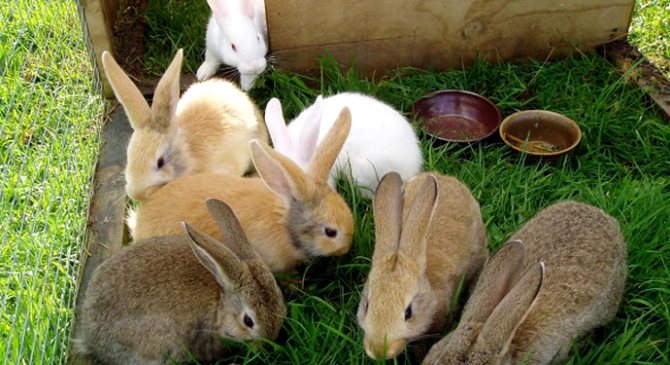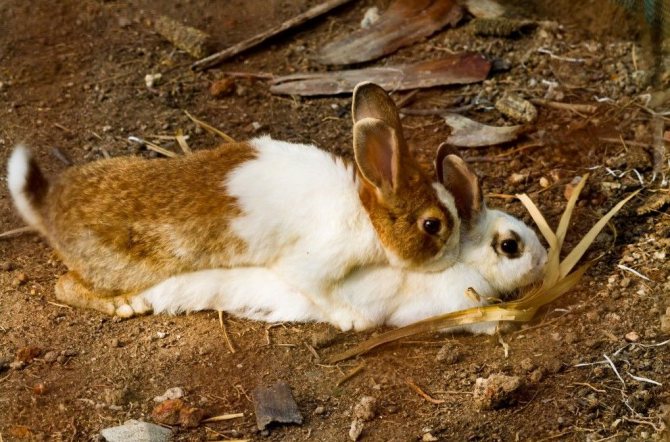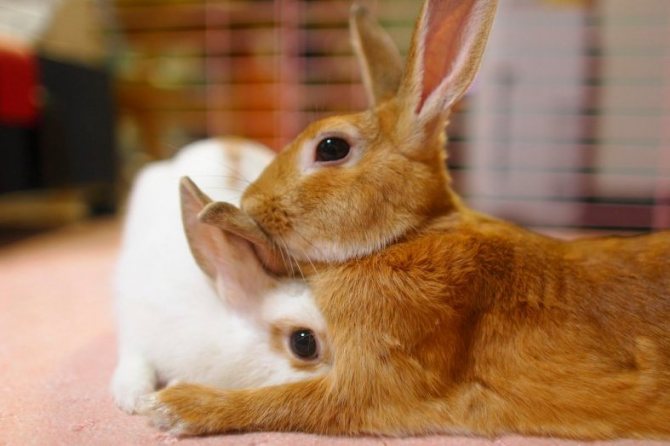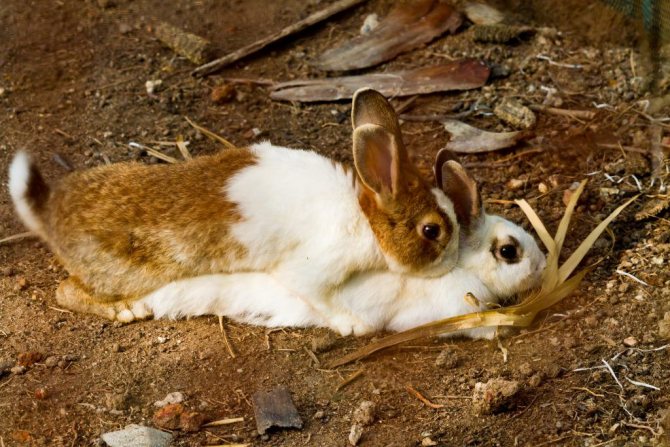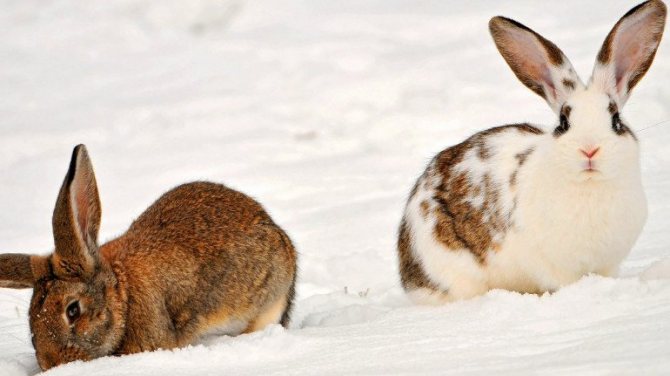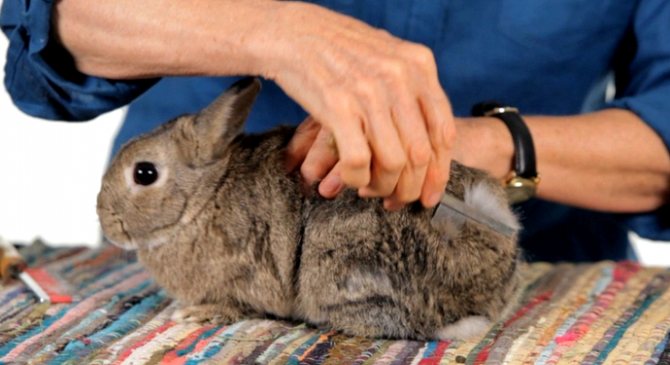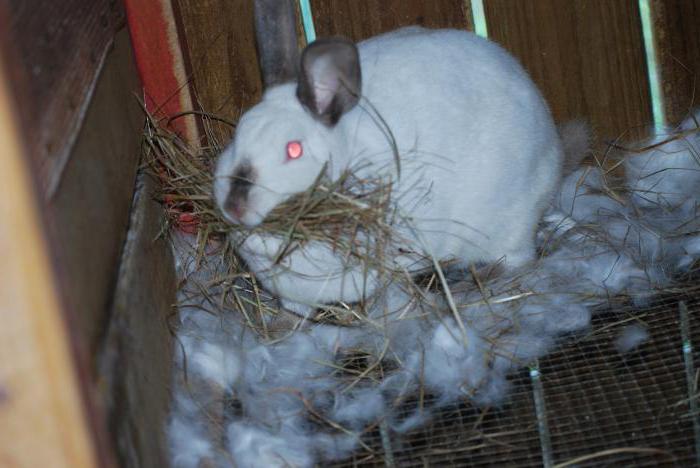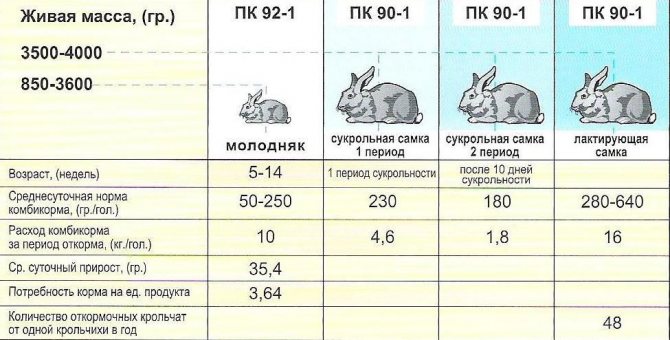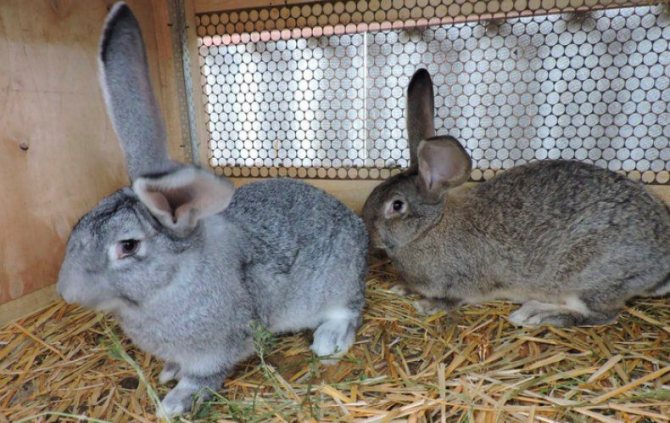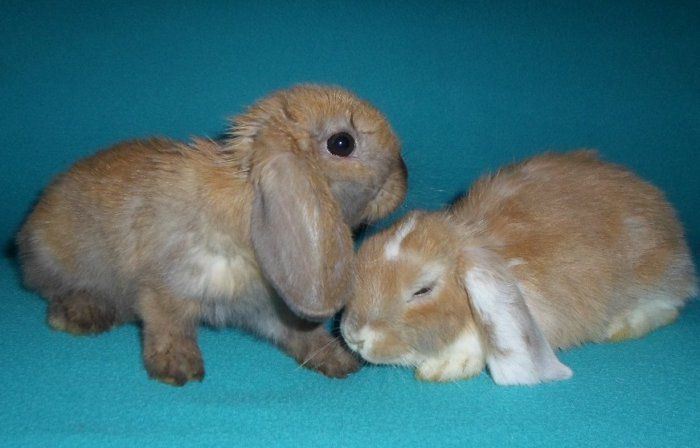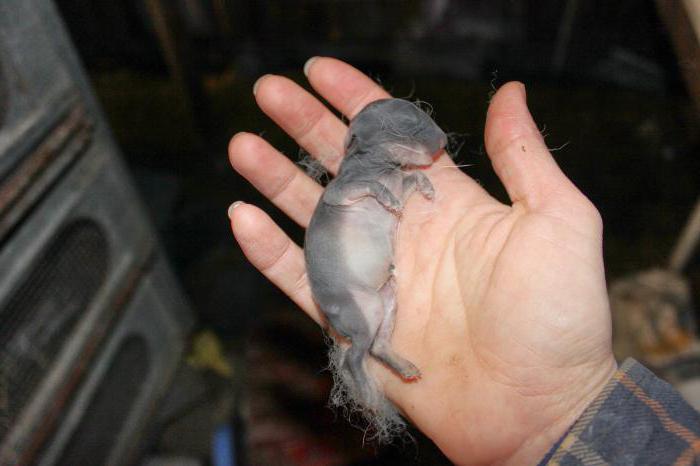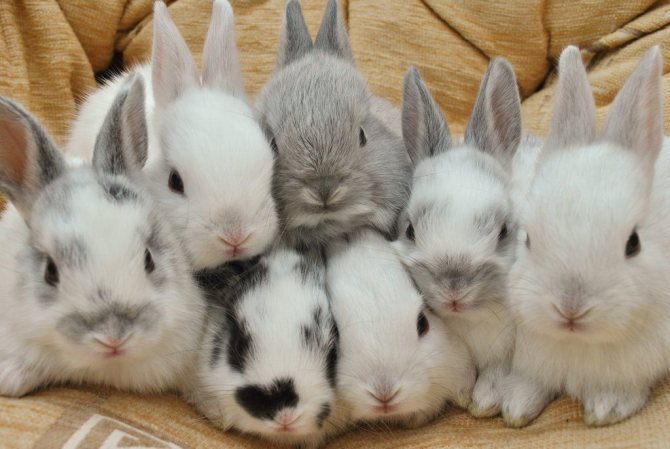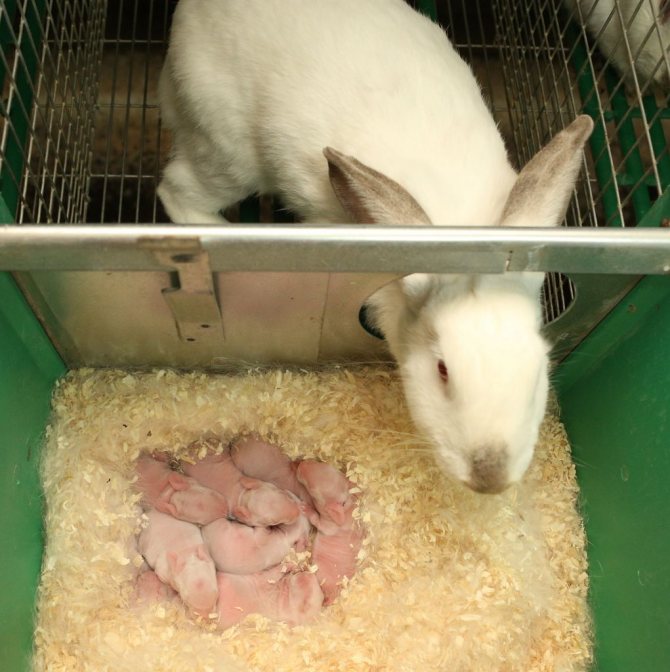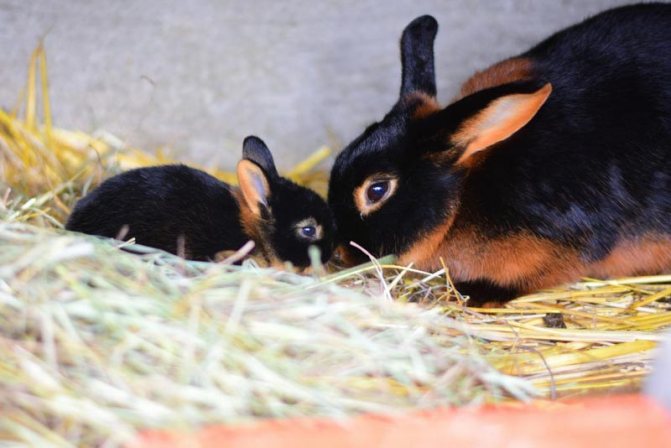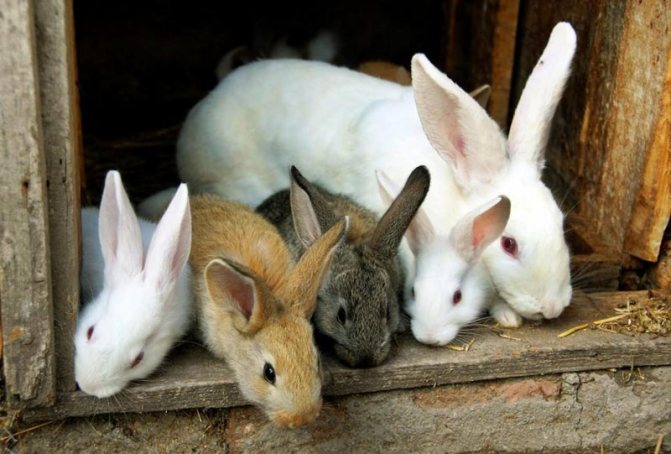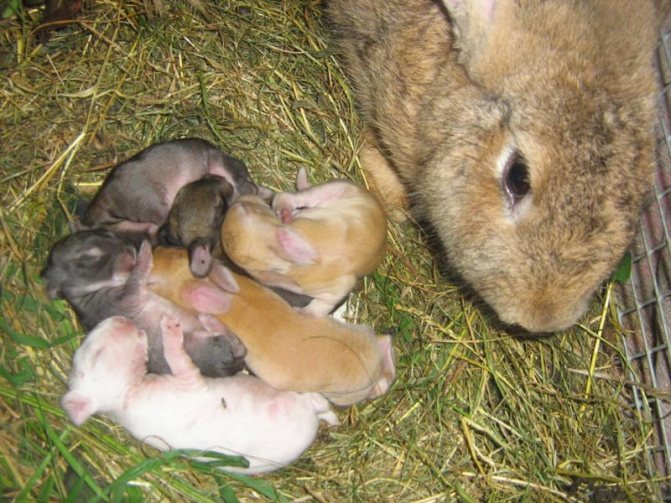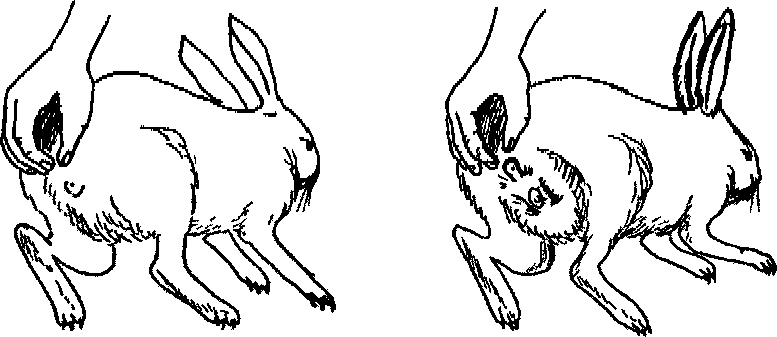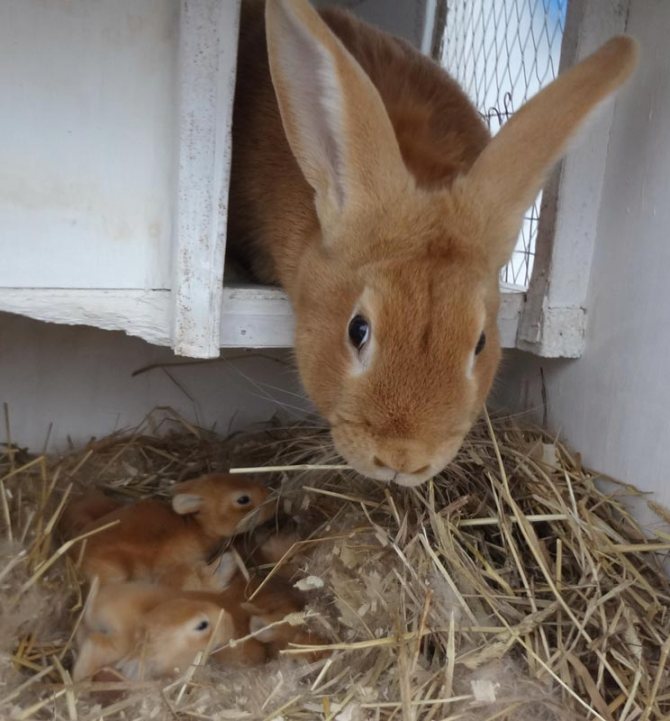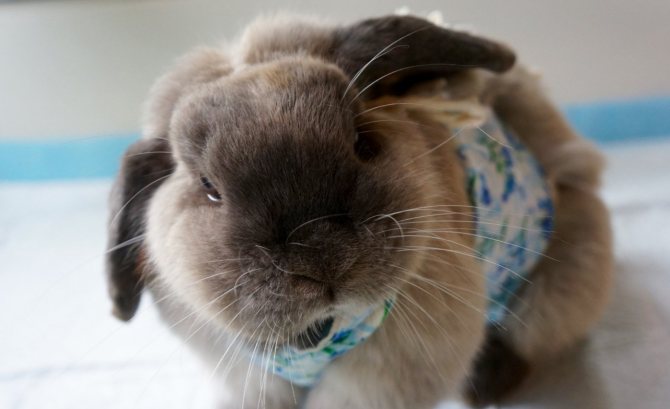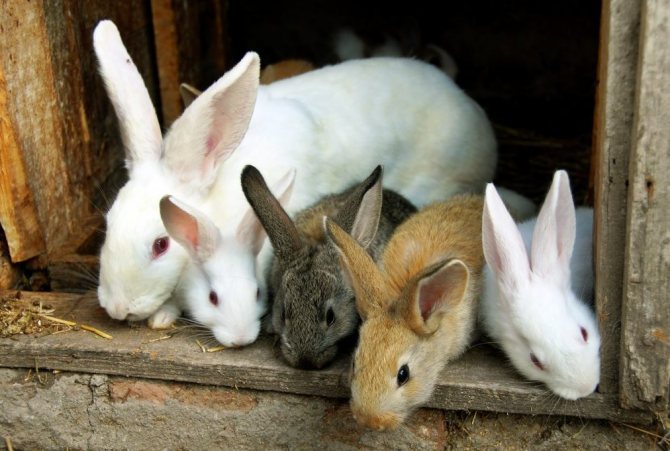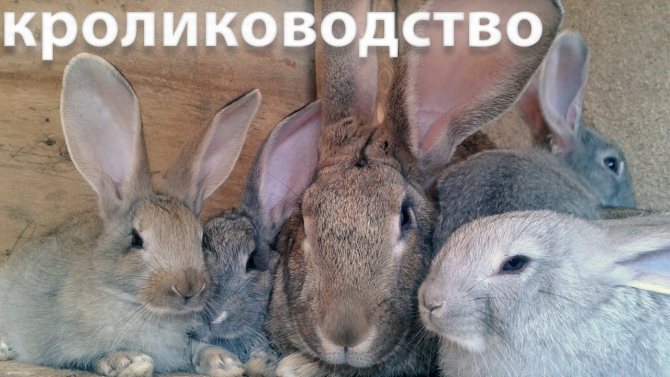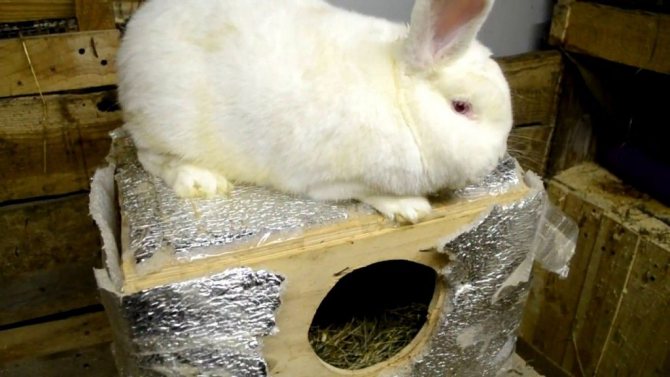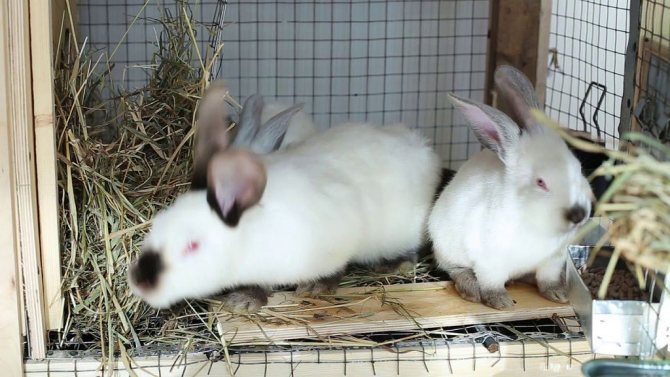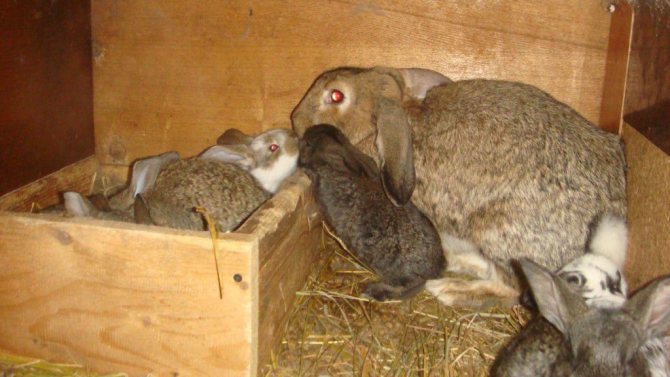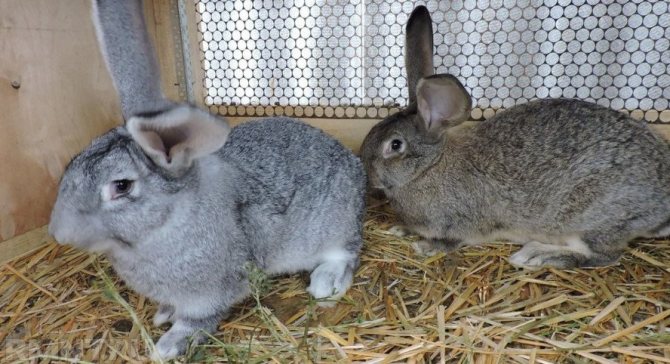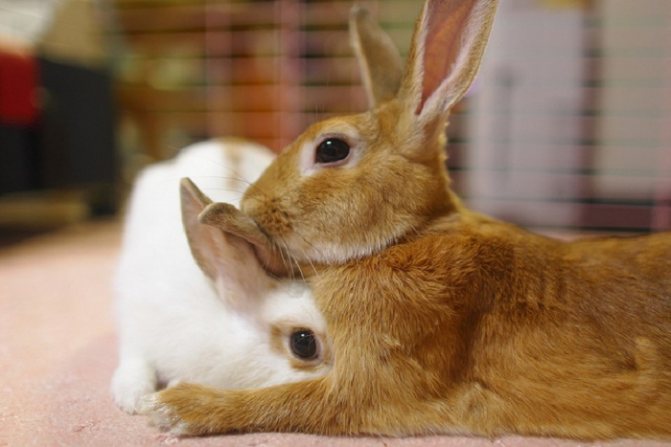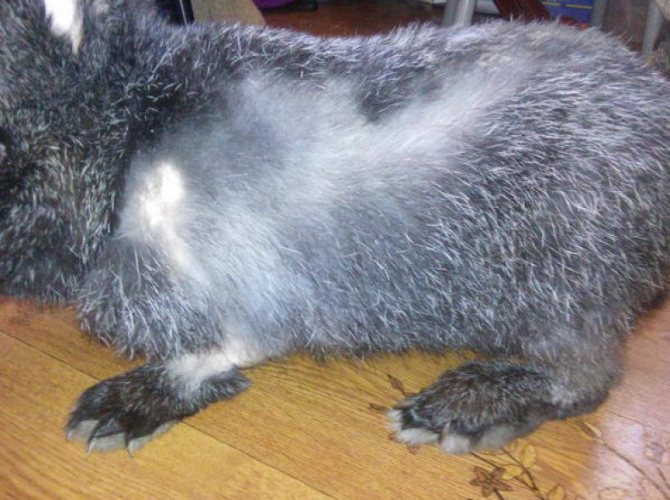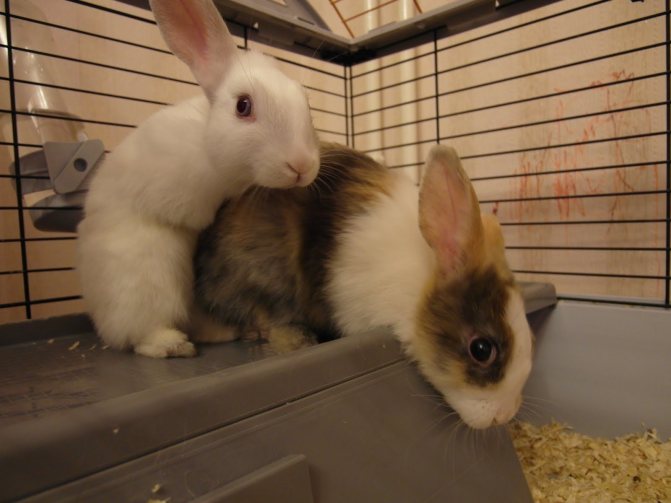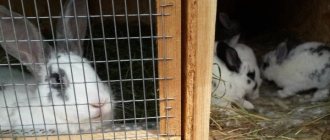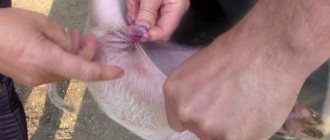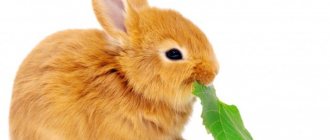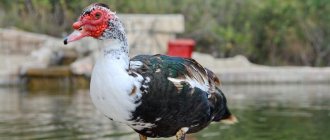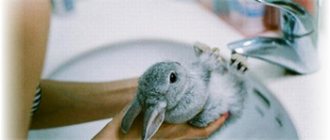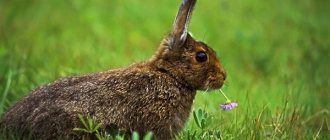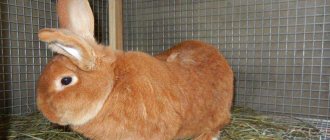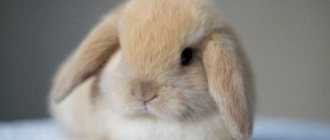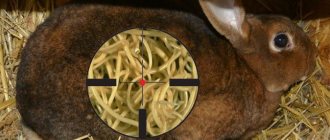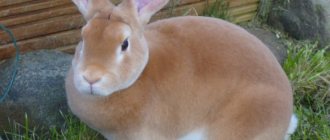At what age do mating
Reproduction of rabbits at home occurs quickly enough also because these animals are early maturing. Their sexual maturity occurs at 3-4 months, depending on the breed. However, it is certainly not worth allowing such young animals to mate. Although the reproductive system in rabbits has already matured by this time, physiologically they are not yet ready for conception and gestation.
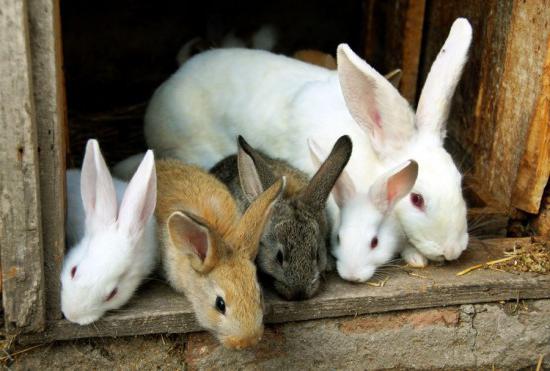
The optimal breeding age for rabbits is 5 months for females and 7-8 months for males. In no case should you rush to mating. If the rabbit is too young, the offspring may be weak or completely unviable. Females, however, who have not reached the age of 5 months, often do not wear their rabbits. In addition, their maternal qualities subsequently deteriorate. They give birth to few cubs and become dairy-free.
Okrol in rabbits
On the eve of okrol, drinkers with water are placed in the mother liquor. If this is not done, the uterus, experiencing strong thirst during the birth, can eat its rabbits.
Okrol occurs mostly at night and rarely in the morning and afternoon. Normal okrol lasts 10-15 minutes. Rabbits are born blind and naked. The uterus licks the rabbits, puts them in the nest, feeds them and covers them well with fluff.
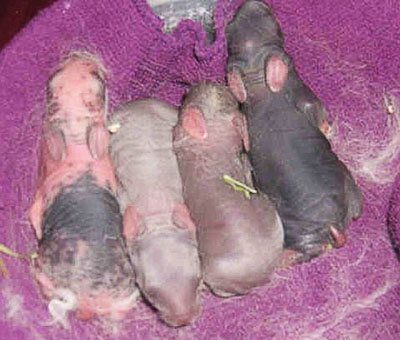

Newborn rabbits
Often primiparous uterus scatter the rabbits around the cage. Such queens need help to collect and put the offspring in the nest, and try to warm the frozen rabbits. To do this, the young rabbits are placed in a basket with warm soft bedding and placed on a warm oven.
To prevent the uterus from eating its offspring, it is necessary to properly feed it during pregnancy, to ensure that there is water in the cage during the birth. From the queens seen eating rabbits, the young are not left for the tribe.
Care of suckling queens and rabbits
Immediately after the end of the round-up, you need to inspect the nest, fix it, remove the stillborn rabbits. This should be done in the absence of the uterus.
In the early days, it is necessary to monitor whether the rabbits have enough milk.
With good milkiness of the uterus, their bellies are always full, smooth, shiny skin, the rabbits lie quietly in the nest. In rabbits that do not have enough milk, the belly is sunken, the skin is wrinkled, they often squeak.
If two uterus were brought in at once, then the rabbits from the low-dairy uterus are transferred to the abundant dairy. Do this on the second or third day after the okrol. "Alien" rabbits are placed in the middle of the nest and covered with down. After a while, they acquire the smell of this nest, and the rabbit does not distinguish new rabbits from her own.
Lactation of the uterus gradually increases until the 22-24th day of lactation, and then the amount of milk in her decreases. Until the 18-20th day, the rabbits feed on almost one mother's milk, therefore, feeding the suckling queens should be plentiful. If the queen does not allow the young rabbits, force feeding should be applied. To do this, the entire nest with the queen is taken to a warm room, the queen is placed on its back and placed on the nipples of the rabbits. When all the rabbits are fed, they are taken to the place. After 2 hours, this feeding is repeated, and this continues until the rabbits get stronger and find the nipples themselves.
On the 5th day, the rabbits are covered with fluff, on the 9-10th day they begin to see clearly, on the 16-18th day they run out of the nest and begin to try the mother's food. From this time on, the uterus is given softer feed (crushed grain, small hay, red carrots, in the summer - good young grass).
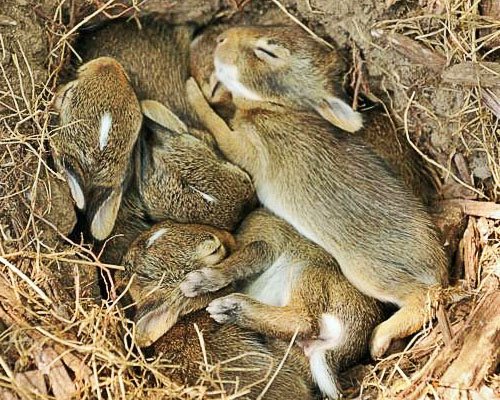

Rabbits begin to see clearly only on the 9-10th day after the birth
Caring for rabbits after jigging
With compacted births, the rabbits are taken away from the queens on the 28-30th day all together. In case of unconsolidated okrols, the rabbits are placed in separate glue on the 45th day. It is possible to keep rabbits with the whole nest only up to three months of age: in 3.5-month-old young animals, puberty begins, and the queens can be fertilized prematurely by a related male.
In the first one and a half to two months after jigging, the rabbits need to be looked after especially well. During this period, young animals grow rapidly, molt and are especially prone to gastrointestinal diseases. It is necessary to feed the rabbits at this time 4-5 times a day in small portions, give concentrates crushed (oats, barley) or soaked (peas, beans, corn). At first, it is better to feed the rabbits with the same food that they received under the uterus. The transition to a new feed should be carried out gradually.
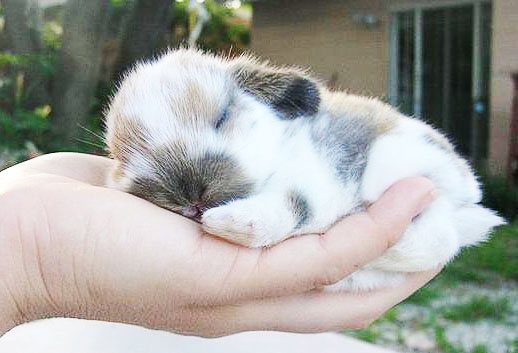

In the first months after jigging from the female, the rabbits need to be looked after especially well.
The rabbits are fed only with fresh, sun-dried grass. Feeding warmed grass causes gastrointestinal problems. After weaning from the uterus, rabbits should be given milk, 15-20 g per head per day.
Strong rabbits should be removed from weak ones immediately.
If they are kept in one cage, strong rabbits will push the weak ones away from food, and they will die. Weak rabbits need to be fed vigorously.
Cleanliness and dryness of the room is necessary for the young rabbits as well as for the young animals of other animals.
How to choose manufacturers
Rabbits reproduce very quickly. However, in order to have as many healthy rabbits in the litters as possible, the breeders should be chosen correctly. Of course, first of all, these should be active, well-developed animals. There are several rules that must be followed when choosing manufacturers. A rabbit should be discarded if she:
- did not become pregnant after two or three consecutive cases;
- raised less than 5 rabbits in two litters in a row;
- ate her cubs.
Krol is discarded if his efforts to procreate are unsuccessful in 30% of cases.
How are partners selected and pairs formed?
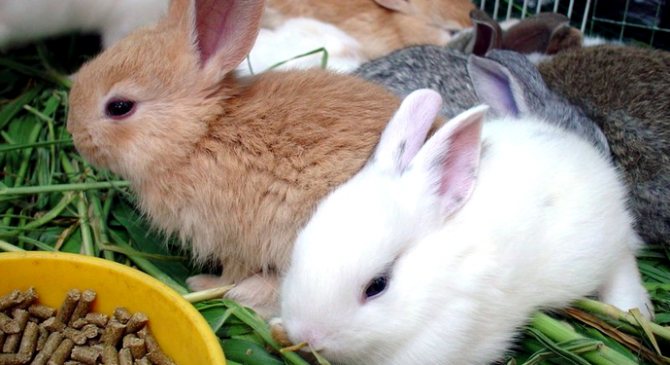

When selecting suitable male and female rabbits for breeding, different criteria need to be considered. Healthy individuals of suitable age and characteristics are selected. Preference is given to large and strong rabbits, which are quite vigorous and active. By the breeding season, they gain weight from 3 to 3 and a half kilograms.
To get strong rabbit offspring, you cannot choose animals older than three years of age, obese rabbits, as well as individuals whose genitals are underdeveloped or damaged.
Rabbits need to pass on their best and special characteristics from generation to generation. New offspring must match the characteristics that distinguish their breed.
For mating, winter rabbits and those born in early litters from the mother are often selected, they are considered the best breeders. Related individuals should not mate. If there are not enough rabbits on the farm, it is better to look from the side, for example, from neighbors. But quarantine and careful checking of new individuals are required.
In addition to a selection of producers with good activity and strength, it is worth taking a closer look at their mother and brothers or sisters.Predominantly weak or painful droppings, especially mothers with disabilities such as early miscarriage, bad temper, and others, are likely to repeat negative characteristics.
You can make an individual selection of male and female. Also, rabbit breeders often form pairs, where it is important how experienced the males and females are.
It is best when more than one mating is performed at the same time. If babies are in short supply or oversupply, this will be compensated, and in the future it will be easier to select grown animals for subsequent reproduction.
Breeding rabbits: what else is worth knowing
Among other things, manufacturers must be of normal weight. From animals that are too thin, not particularly viable babies are usually born. Obese rabbits often do not even hunt.
It is also highly discouraged to breed animals from the same litter. In this case, the rabbits will be born weak and will be more susceptible to various kinds of diseases.
A young female is best mated with an adult male, and vice versa. The mating is usually done when the female is hunting. In summer, this period in rabbits occurs every 5-6 days and lasts 3-5 days. In winter, the female hunts every 8-9 days.
Features of winter breeding
Rabbits tolerate cold well and are able to reproduce in winter. However, during severe frosts in the rabbitry, it is still better to increase the heating. Rabbits do not tolerate drafts. In addition, in the rabbitry and in the cages, it must be dry so that the animals do not catch cold.
More on the topic: Advantages and disadvantages of Flandre rabbits
Igor Nikolaev
auto RU
In winter, mating is best done during the daytime. There are no differences between summer and winter mating, there are only nuances. Firstly, the reduction in daylight hours negatively affects the activity of animals, therefore experienced rabbit breeders often "extend" the day with the help of artificial lighting. Secondly, during winter birth, there is rarely more than one rabbit in the litter.
This is not a pathology, but a feature of rabbit physiology.
In winter, newborn rabbits are better placed in a warmer place than where adult animals are kept.
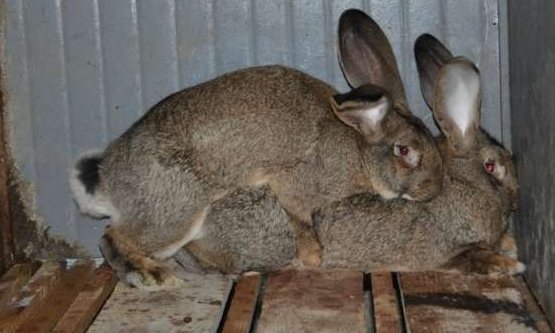

How to mate
In order for this enterprise to be crowned with success, the rabbit is placed in a cage next to the rabbit. On the contrary, it is not worth doing. In foreign territory, the rabbit will not feel too confident.
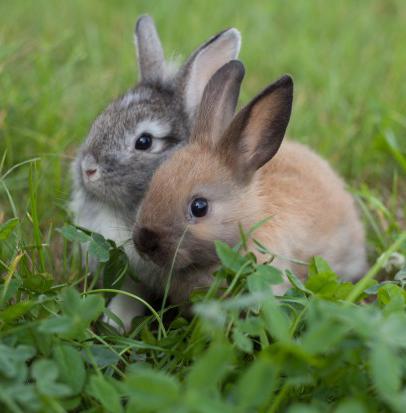

Drinkers and feeders should be removed from the cage before mating. Reproduction of rabbits both in the wild and at home occurs quickly, primarily because these animals are very active. Therefore, in the process of pairing, all objects in the cage will most likely be turned over. Also, the place where the mating takes place should be carefully examined. There should be no sharp objects (nails, wire sticking out, etc.) in the cage. They can injure animals.
Inbreeding accidental and forced
Inbreeding is the mating of related rabbits. This mating of rabbits negatively affects both the health and the size of the offspring.
However, some rabbit breeders deliberately go on crossing such animals, and for quite a long time. In order to get a new breed.
Accidental inbreeding is possible in cases where the young are not bred on time.
Since such crossing is harmful, you need to periodically buy males from other families.
If there is no opportunity to pour in fresh blood, the most distant relatives available are mated.
Control mating
In order to be sure that fertilization has occurred, the rabbit should be added to the male again after two weeks. If pregnancy has come, she will start to run around the cage and behave aggressively towards the "gentleman", not allowing him to come to her.
The fertility of the female can also be determined by palpation. In this case, the animal is seated on the table and, holding its head, probes the abdomen closer to the sacrum. In pregnant females, it is very dense. Also, with your fingers, you can feel the fruits the size of a small nut, located in a chain.
Preparing for mating. What to do?
Before the breeding season, the rabbits need to be prepared for it.
For 15-20 days, it is necessary to examine the animals, determine their weight and general health. Sick and weakened individuals are not allowed to mate. If a lack of weight is found, such rabbits are transferred to enhanced nutrition.
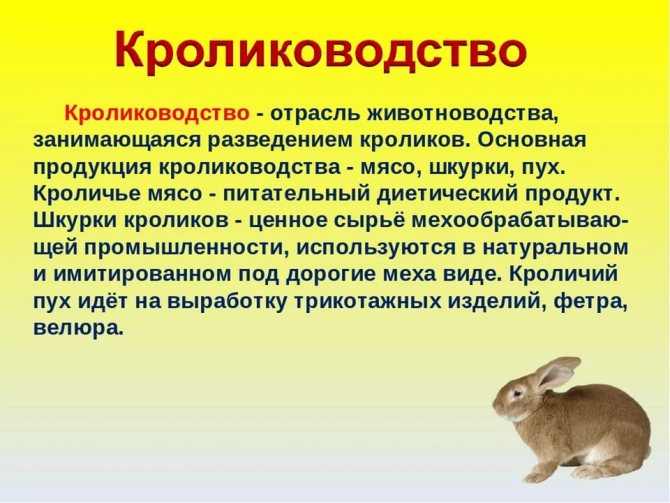

Also, the preparation should apply to the composition of animal feed. Two weeks before mating, a mixture of boiled potatoes with steamed oats is added to the diet of males. The rabbits are given concentrated feed, without changing the amount of branch feed and hay. It should be remembered that overfed animals reproduce worse. If obesity is found in a rabbit, then concentrated types of feed and food with a high concentration of starch are almost completely removed from its diet.
More on the topic: The rabbit does not tear fluff, does not make a nest and carries hay in her teeth before giving birth
Before mating, it is necessary to inspect the nipples of the female (there are eight or ten of them), and the external genitalia. Rabbits with deviations from the norm are discarded. Also, it is impossible to happen those animals that are actively molting.
For the best mating results, several conditions must be met:
| № | Helpful information |
| 1 | young inexperienced females should be bred with adult breeders who have already proven themselves to be of high quality of the resulting offspring |
| 2 | more experienced, successfully giving birth several times, it is better to plant rabbits with young males |
Number of manufacturers
The question of how rabbits breed at home also comes down to how to choose the right ratio of the number of males and females. Usually a young rabbit is used as a producer 1-2 times every other day. An adult male can cover up to 4 females daily. However, he should be allowed to rest from time to time. Based on this, the number of manufacturers is calculated.
However, a novice rabbit breeder should also know that there should be at least two rabbits for one male. Otherwise, its quality as a manufacturer may deteriorate. The optimal ratio is considered to be 8-12 females per adult rabbit.
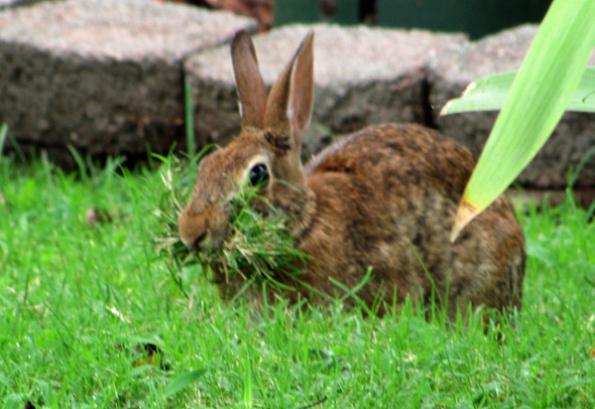

How to tell a rabbit from a rabbit
Even inexperienced farmers know how domestic rabbits breed. How to distinguish a female from a male should be clarified in more detail. After all, the sex determination procedure is important not only for reproduction, but also in order to be able to safely raise your pets. If individuals of different sex are not promptly divided into separate cages, then males can arrange serious fights for rabbits and injure each other.
Mating cows
In male rabbits, the external genitals are clearly visible. However, it will be possible to determine them no earlier than a month after birth. In addition, in males, the testicles descend into the scrotum only by the age of 3 months; with severe fright, they can be pulled back into the abdominal cavity.
Attention! If a farmer acquires a thoroughbred young rabbit for further reproduction, then you must immediately get a veterinarian's conclusion about the absence of pathologies of the reproductive system.
Puberty in domestic rabbits occurs early enough. By this time, it is already necessary to determine the sex of the young and distribute it to individual cells. The rabbits are turned over onto their backs and the skin is gently pushed towards the anus with the fingers.At the same time, in females, a loop becomes visible, in males, a penis emerges to the surface, in shape similar to a cone.
Pregnancy and childbirth
The female bears the rabbits for about 29-33 days. Just before giving birth, she begins to build a nest. First, the rabbit pulls dry hay to some corner. Then he lines the bottom of the nest with his down, tearing it out mainly from the chest. At this time, an additional drinker must be placed in the rabbit's nest. Otherwise, she can simply gnaw off the cubs.
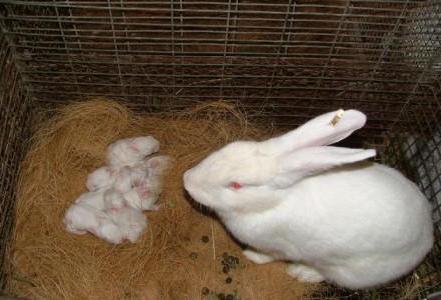

Rabbits usually give birth either at night or early in the morning. They usually pass not too long - 20-30 minutes. Rabbits are born blind, helpless and naked. To keep them from freezing, the rabbit wraps them up in her down.
After giving birth, owners should definitely check the droppings for stillborn babies. This happens quite often in rabbits. A dead rabbit, if not removed, will begin to decompose in the nest, attracting insects, which, of course, is fraught with infection of healthy individuals.
How often do rabbits breed?
Up to 9 okrols can be obtained from one rabbit per year, but this greatly depletes the rabbit's body. After birth, the female needs time for her body to recover and be fully ready for a new reproduction of offspring. Basically, this break lasts about 70 days. During this period, females are placed in separate cages.
On a production scale, the female is used for 1 year, but when raised for the tribe, a rabbit with excellent performance and characteristics is used for up to 3 years. In this case, the female is treated more carefully and receives an average of 5 offspring per year.
You will be interested in learning how rabbits mate.
Correct mating of rabbits is not difficult if you know at what age and how to do it correctly. For a pregnant female, it is necessary to create certain conditions and then transplant offspring in a timely manner.
Why does the rabbit throw out the cubs
It often happens that the female throws out the rabbits from the nest. The reason for this phenomenon is that the cubs are too tightly hooked on the nipples, and the rabbit simply pulls them out when leaving the nest. In this case, the baby should simply be carefully put back.
Some bunnies eat their droppings. This usually happens if the female did not receive a sufficient amount of food during her gestation and she does not have enough milk. Also, those rabbits who develop mastitis often gnaw their droppings. To avoid this disease, the animal should be kept on a clean, dry bedding. In any case, good care of the rabbits should be ensured. At home, reproduction will then be much more successful.
In the diet of a pregnant rabbit, it is imperative to include a sufficient amount of foods containing proteins. You can not feed the sucrol animal only with grass, vegetables and root crops. Be sure to give him barley grits or crushed (you can oatmeal, but it's worse), as well as boiled potatoes and dried white bread. Grain should only be purchased from trusted producers. You should not buy barley crushed at the bazaar. Most infectious diseases in rabbits are transmitted through feed.
Where to keep and what conditions need to be created for a pregnant rabbit
A pregnant rabbit should be placed in a separate spacious cage, the size of which can accommodate 6 adults, because after the roundabout, the female will be there with her offspring until the rabbits are weaned from her. This must be done in the first days after conception, since moving the pregnant female after she has begun to equip the nest will be stressful for her. The cage should be in a quiet place where the animal will not be disturbed.
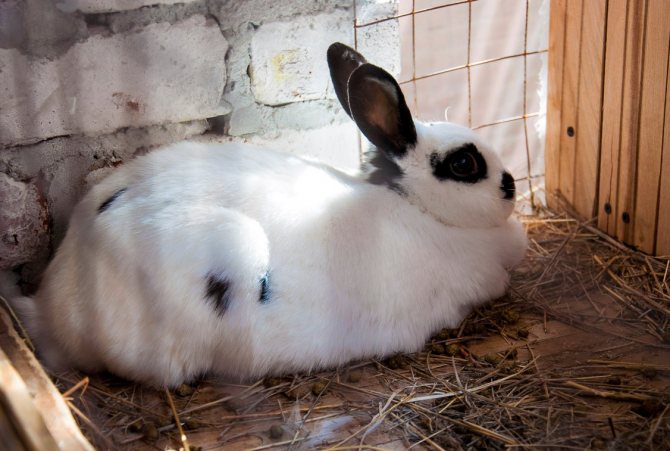

A few days before the expected birth, it is necessary to disinfect the cage and dishes, and also put a box made of cardboard or wood with an entrance, which will play the role of a nest. Straw should be laid on its bottom. In winter, it is necessary to take measures to warm the cage with the offspring - overlay the sides and top with foam, pour a thicker layer of straw on the bottom. In the summer, the cage should be in the shade. Good ventilation must be present at any time of the year. The ambient temperature must not exceed + 30 ° C or below -6 ° C.
Read more about pregnancy in rabbits.
It is good if the temperature is in the range of + 18… + 22 ° C. Lighting should be at least 12 hours a day. Drafts and dampness should be absent. A pregnant and lactating rabbit should always be provided with clean water. The diet must include vegetables, cereals and fresh grass (or hay). Meat and bone meal, fish oil and vitamins should also be given. You should not overfeed or underfeed animals - food should be according to the norms recommended for pregnant animals.
Baby development
In the event that the female is chosen correctly, the reproduction of rabbits is really fast. In addition, at the same time, the cubs develop very well. After two weeks, they weigh 2-3 times more than after childbirth, and after a month - 10 times. This rapid development is due to the special properties of rabbit milk. It contains more proteins than any other mammal. Rabbit milk is even fatter than goat's milk.
The cubs are deposited from the mother at the age of 45 days. Previously, it is undesirable to do this.
How should rabbits eat during the mating season?
The breeding season of animals is very responsible, they must be ready for it, be strong. To do this, the rabbits are given nutritious food. Before the process of mating, the rodents need to be fed a little, increasing the portions of grains, beans, mixed feed. Oats are given in greater quantities, steamed together with potatoes, it will be doubly useful.
Feeding begins half a month or a week and a half before mating. It is good for females to add sprouted wheat to the diet. Feeding the rabbits well will help increase the litter size and improve the health of the newborn animals.
In the preparatory period, in addition to excellent nutrition, it is important to process the premises where rodents are kept. Couples themselves are vaccinated, they are also treated for parasites, or preventive measures are taken.
How to determine the gender of a rabbit
Only healthy cubs with pronounced signs of the breed are left for the tribe. Breeding domestic rabbits on a farm in this case will be much more successful. Each litter must have the largest bunny. Therefore, summer residents usually have no problems with the choice of a future producer from their own herd.
Finding out the sex of the rabbits is easy. This can be done as early as two to three weeks of age. To determine the gender of the rabbit, they take it in their arms, turn it upside down and lay it on its knees, with its hind legs away from itself. Next, you need to stretch the skin of the animal in the genital area. In rabbits, a long slit will be noticeable, reaching almost to the anus. In males, only a small tube hole is visible.
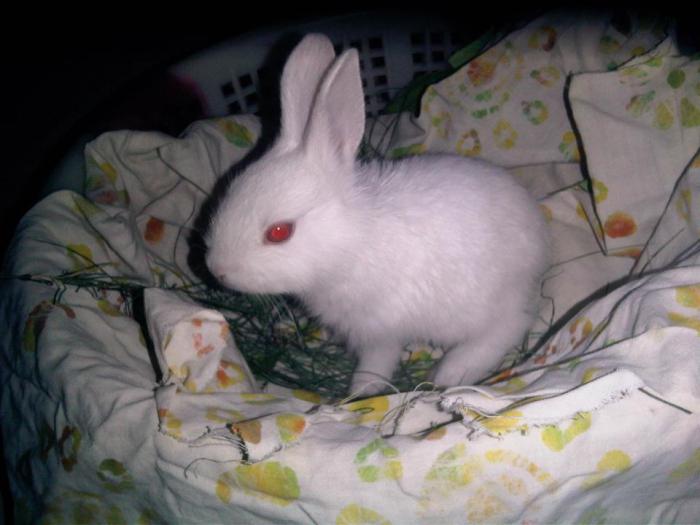

Optimal age and best time to mate rabbits
Novice rabbit breeders should know that females of almost any breed are ready for the first mating at the age of five months, while their weight should be at least three kilograms (if these are not decorative small breeds). It should also be remembered that the smaller the breed, the earlier the first mating can be carried out. The same is true in the opposite sense: the larger, the later.
For example, females of black-brown, white or gray giant breeds, which belong to large rabbits, are allowed to mate for the first time about two to four weeks later.However, overexposing the animal is also not worth it, since it gains weight, which negatively affects its ability to fertilize.
More on the topic: Brown rabbit
The male rabbit is ready to mate at the age of 6 to 8 months. How do you know when a rabbit is ready to mate? Rabbits can happen at a certain time, which is called the females' hunting period. The onset of this period can be determined by the behavior of the rabbit and by some external signs.
Usually, females behave calmly and quietly, but with the onset of the hunt they begin to worry, drags bedding, scatters food, sometimes begins to nibble the fluff on their breasts. Refusal to eat is possible. The loop of the genital organs of the rabbit is pale pink at normal times, not enlarged. When the female begins to "want" the male, her loop swells and becomes bright pink. Such signs appear in females, regardless of their breed.
Hunting in females that have already brought offspring can begin one or two days after giving birth and lasts for five days. The next two days (6-7th), it goes down, and then there comes a time of rest. The frequency of hunting is individual. Some females have a cycle of 9 days (in summer), while others have 15-20 days (other periods of the year).
Rabbits breed all year round. In summer, it is best to mate in the morning and evening. The most unfavorable time for mating is October and November, since during these months the animals are usually lethargic.
The high fertility of rabbits is due to the fact that females are ready for mating already on the second day after birth. However, you need to give them time to feed their offspring.
Breeding of decorative breeds
Farm owners that breed animals for sale usually know all about rabbits well. The maintenance, reproduction and feeding of these animals are procedures that are not particularly difficult for them. However, those who acquired the animal simply as a pet often make unforgivable mistakes, as a result of which the animal sometimes even dies. In order not to lose your pet, you should definitely follow these rules:
- In no case should you drastically change the animal's diet. This is especially true for young rabbits. The new feed should be introduced gradually, increasing the dose over the course of a week.
- It is not recommended to give babies foods that can cause gastrointestinal upset. These include, for example, raw potatoes, beets and cabbage.
- Animal cages should always be clean. Reproduction of decorative rabbits occurs as quickly as meat. However, these animals die very simply. This can happen from anyone, even the most harmless disease.
- Drinkers and feeders should be washed daily for the same reason.
Beef breeds are looked after in about the same way. That is, they do not drastically change the diet and try to keep the cells or enclosures clean. As for the reproduction itself, the mating process in decorative rabbits occurs in the same way as in ordinary ones. The female is placed in the cage with the male, and not vice versa. A control mating is carried out two weeks later. The cage with a pregnant decorative rabbit should be placed in the quietest place in the apartment. These animals do not tolerate all kinds of noises.
This is how animals like rabbits are bred. Reproduction and caring for them are procedures that require compliance with certain rules. Rabbits' health is really poor. Therefore, it is impossible to violate content technologies in any case.
Mating methods
Rabbits can reproduce in different ways, among which the following are distinguished:
- For free mating, up to 10 females are added to one rabbit. For several days, they are monitored to exclude conflict situations.The disadvantages of this method are the lack of breeding records and some confusion with parents, an increased risk of infectious and parasitic infections.
- Artificial insemination takes place with human participation, which requires veterinary knowledge and special skills. In this case, a mastic crawl is selected, from which sperm is taken. Then the collected biomaterial is injected into the rabbit with a special syringe. This method is applicable for individual farms, for selection development.
- Hand knitting allows you to control the entire process, starting with the selection of producers. In this method, rabbits are bred in the presence of sexual activity, and the results are carefully recorded. This makes it possible to reject individuals whose fertility is less than 30%, to keep accurate records and plan the number of livestock.
Mating technology at home
Even the best selected breeders must be constantly monitored during mating - if something goes wrong, the animals can fight instead of copulating.
Read the rules for breeding rabbits as a business.
Coating process
The rabbit covers the female lying on her stomach and makes intense frictions. At the moment of climax, the male makes a squeak or rumbling sound and falls to one side. For greater confidence in fertilization, the process is repeated several more times. After that, the female is deposited in the prepared cage.
If the rabbits did not mate, then after a few hours the female is again put on the same male. If the rabbit fails again, the next day is offered to another
Control mating
A few days after intercourse, an attempt is made to mate again - control mating. This process should show whether fertilization has occurred. The pregnant rabbit will simply not allow the male to approach her and will in every possible way avoid him, up to the point of attack. Based on the results of the check, the animals are seated in separate cages.
Checking the results
The so-called fertility test is carried out 10 days after the alleged fertilization. The female is seated on a flat surface and the lower abdomen is palpated. With successful mating results, small seals (up to 2 cm in diameter) should be felt in this area, which will develop into rabbits in the future.
Find out how pregnancy goes in rabbits.
Culling animals
Rabbits are carefully examined 2 weeks before mating.
Rejection criteria:
- Age over 3 years old.
- Loss of maternal instinct and killing of offspring. Frequent mating leads to depletion of the body, rabbits are born weak, unviable.
- Recurring miscarriages in a rabbit and the birth of dead babies.
- Presence of diseases, rashes, abrasions, tumors, purulent discharge and an unhealthy condition of the reproductive organs. Animals are inactive, have poor appetite, physical injuries to the paws and other abnormalities.
- Lack or excess weight. Excessively obese animals are inactively mating or completely refuse to mate. Skinny rabbits have weak, non-viable offspring.
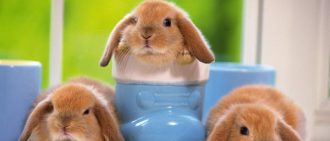

Be sure to read:
How to determine the gender of a rabbit: external differences, sex characteristics, behavior
The culled but healthy rabbits are fattened and sent to slaughter. Individuals with external signs of the disease are urgently destroyed.
Important! Only a veterinarian can diagnose diseases in animals, including infectious ones.

